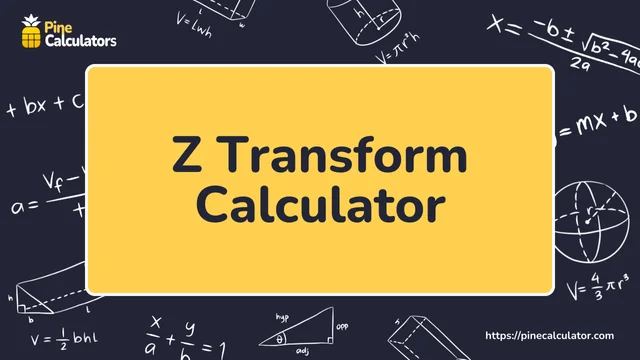Introduction to Z Transform Calculator:
Z transform calculator is an online tool helps to calculate the Z-transform of a discrete-time signal or system and used in digital signal processing (DSP) and engineering. It is used to transform the time domain function (real value or complex value) to the frequency domain.

It is a beneficial tool for students, professionals, or researchers as z transform method helps to analyze discrete signal processing by simplifying the signal processing into the frequency domain.
What is Z Transform?
Z transform is a process that is used to convert a real-value function into a complex value function in discrete mathematics. It is used to analyze the signal processing and control theory to change into the frequency domain.
There are different properties of Fourier transform like linearity, time-shifting, and convolution, which are useful in signal processing. You can use the inverse Z-transform to transform the given function back into the time domain.
Z transform Formula:
The Z transform formula is based on a sequence of real or complex-valued functions in a discrete-time domain.
$$ X(z) \;=\; \sum_{n= -\infty}^{\infty} x[n]z^{-n} $$
- x[n]: sampling number of valued functions
- n: the indexing,n = 1, 2, 3, 4….
- z: the series of variable
- X(z): the z transform
How to Find the Z-Transform?
To find the Z-transform problem, you can use our z transform calculator uses the following simple steps which will help you understand how to convert a discrete-time signal into the frequency domain to the Z-domain.
Step 1: Identify the discrete-time signal x[n] by transforming the initial condition given in the function.
Step 2: Apply the Z-transform formula X for finite-length sequences:
$$ X(z) \;=\; \sum_{n= -\infty}^{\infty} x[n]z^{-n} $$
Step 3: Substitute the signal x[n] into the Z-transform formula to evaluate the sum and simplify it.
Step 4: Identify the values of z for which the Z-transform converges for determining given system stability.
Step 5: You can use the algebraic or partial fraction decomposition method to simplify the Z-transform.
Example of Z-Transform:
A solved example of z transform is given below to let you understand how to solve z transform problems manually.
Example: Find the Z-transform of the following discrete-time signal, where u[n] is the unit step function.
$$ x[n] \;=\; a^n u[n] $$
Solution:
Given data is:
$$ x[n] \;=\; a^nu[n]\; and\; n \;=\; 0,1,2,... $$
Apply the formula of z transform,
$$ X(z) \;=\; \sum_{n=0}^{\infty} a^n z^{-n} $$
$$ X(z) \;=\; \sum_{n=0}^{\infty} (az^{-1})^n $$
The given real value function becomes the geometric series so,
$$ \sum_{n=0}^{\infty} r^n \;=\; \frac{1}{1-r}\; if\; |r| < 1: $$
The sum of infinite geometric series become,
$$ X(z) \;=\; \frac{1}{1 - az^{-1}} $$
Check the series of convergence which is,
$$ |az^{-1}|< 1 \rightarrow |z| > |a| $$
As you can see the geometric series is already converge,
$$ X(z) \;=\; \frac{1}{1-az^{-1}}, |z| > |a| $$
Therefore the z-transform of a given function is,
$$ x[n] \;=\; a^n u[n] \rightarrow X(z) \;=\; \frac{1}{1-az^{-1}}, |z| > |a| $$
How to Use the Z Transformation Calculator?
Z transformation of functions calculator has a simple design that helps you to solve the z transform question instantly. Therefore, follow the given steps to get results without any trouble.
- Enter your function in the input box to find the z-transform solution.
- Review your given input function to get the exact solution of the z-transform question.
- Click on the Calculate button to get the result of the given z-transform function problems.
- If you want to check the working behind our z transform calculator then you can use the load example.
- Click the “Recalculate” button for the calculating more examples of z-transform functions.
Output From Z-Transform Calculator:
Z transformation calculator provides you with a solution when you click on the calculate button. It may include as:
- In the Result Box:
Click on the result button so you get the solution of your z-transform question.
- Steps Box:
When you click on the steps option, you get the result of Z Transform questions in a step-by-step process.
- Plot Step:
When you click on this option it will give you the solution in the form of a graph for visual understanding of the z transform function.
Benefits of Z Transformation of Functions Calculator:
Z transform calculator has multiple benefits that you get when you use it to solve z transform problems. Our tool only takes the real or complex value function to provide a solution. The benefits are:
- Z-transform calculator is a reliable tool as it always provide accurate solutions of given z-transform problems.
- It is an efficient tool that provides solutions of the given z-transform problems.
- Z transformation calculator is a learning tool that helps you to learn the concept of z transform very easily.
- It is a handy tool that solves z transform problems quickly without manual calculation.
- Z transformation of functions calculator is a free tool that allows you to use it for the calculate the real-valued functions for free.
- It is an easy-to-use tool, anyone or even a beginner can easily use it for getting the solution of z-transform problems.










